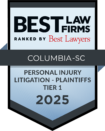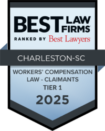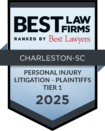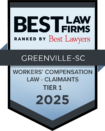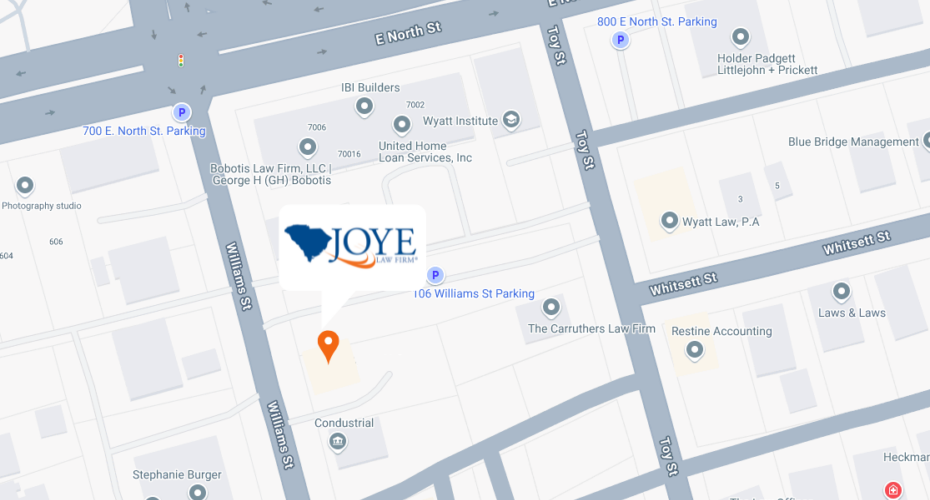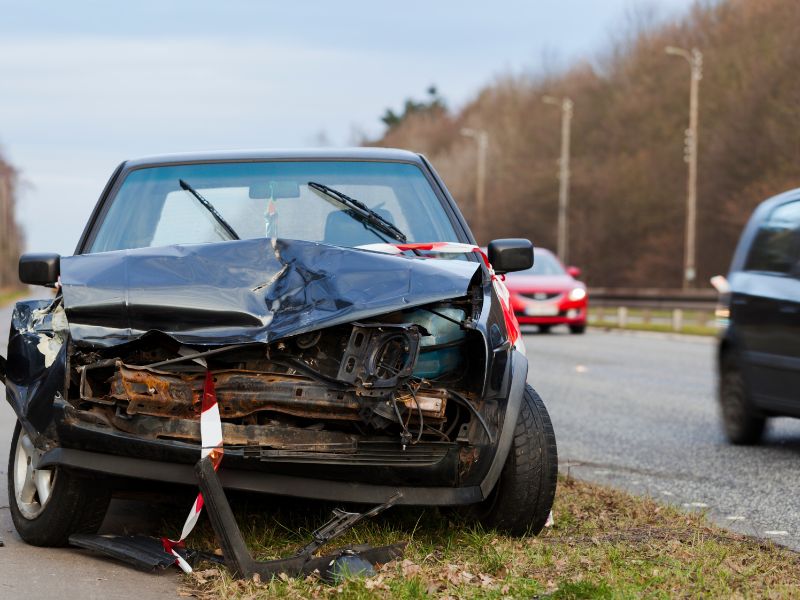
Head-on collisions are known for being particularly deadly, and with good reason. According to the National Highway Traffic Safety Administration (NHTSA), head-on collisions accounted for more than 10 percent of all fatal crashes nationwide in one recent year, despite making up just 2 percent of crashes overall. Those who survive head-on collisions are frequently left with debilitating injuries, significant financial losses, and severe emotional distress.
Have you been hurt in a head-on crash that wasn’t your fault? Then contact Joye Law Firm immediately. Our Summerville head-on car accident lawyers have nearly 250 years of combined personal injury experience and are known throughout South Carolina for the exceptional results we deliver for our clients. We understand how devastating a head-on car crash can be and want to help however we can. We can take care of every aspect of your case, from helping you find the medical treatment you need to negotiating a fair insurance settlement to bringing your case to court, if necessary.
Nothing can erase the effects of a head-on collision, but you have options for recovering compensation for your injuries. Contact our Summerville head-on car accident lawyers today for a free consultation.
What Is a Head-On Collision?
Head-on collisions occur when the front ends of two vehicles traveling in opposite directions collide. These accidents are extremely hazardous because there is nothing to mitigate the force of the collision.
Common Causes of Head-On Car Accidents
There is no single cause of head-on car accidents in South Carolina, though there are several common contributing factors, including:
- Impaired driving– Drivers under the influence of alcohol or drugs are much more likely to cause a head-on collision. They have dulled reflexes, making it more difficult to react in time to avoid a collision. Their judgment is impaired, leading them to take unnecessary risks that can lead to a crash. Most crucially, impaired drivers are much more likely to fall asleep at the wheel, which can cause them to drift out of their lane and into the path of oncoming traffic.
- Distracted driving– Motorists who are not fully engaged with the crucial task of driving have a much higher chance of causing a head-on collision. A driver who is talking on a cellphone or texting does not have both hands on the wheel and may accidentally drift into another lane. If they are adjusting in-vehicle controls or using a navigation device, they are not watching what is happening around them and may not see another vehicle coming toward them. And, if they are talking to passengers or looking at traffic in another lane, they are not concentrating on driving and may miss a potential hazard in their path.
- Driver fatigue– Driver fatigue has become a significant safety concern as more drivers work unusual shifts or take gig work to make ends meet. According to the National Safety Council, driving after more than 20 hours without sleep is equivalent to driving with a blood-alcohol concentration of 0.08 percent, the legal limit in South Carolina. Fatigued drivers are much more likely to fall asleep at the wheel, make errors of judgment, and not see other vehicles around them, all factors that can lead to a head-on collision.
- Speeding, especially around curves– The faster a car moves, the harder it is for drivers to spot potential dangers and stay in control. Drivers who speed around curves may leave their lane and cross into the path of cars in the opposite direction. Because the curve may have blocked the driver from seeing other traffic, they may not realize a head-on collision is imminent until it is too late.
- Unsafe passing– Unsafe passing on non-divided highways is a common cause of head-on collisions. If drivers attempt to pass without giving themselves enough time and space to make it back into their lane, they can collide with traffic coming from the opposite direction.
- Driving the wrong direction– When drivers head down the wrong path on a one-way street or highway, the result is often a head-on collision. This can happen if a driver is impaired, distracted, confused, or severely fatigued.
- Mechanical defects– If a driver experiences a tire blowout, their brakes fail, or their vehicle has another mechanical defect, they may lose control and careen into opposing traffic, leading to a head-on collision accident.
- Bad weather– Rain, snow, and other forms of bad weather can make it harder for drivers to safely maneuver their vehicles, making a head-on collision more likely. That said, drivers need to adjust their behavior for poor weather.
Dangers of Head-On Collisions
The reason that head-on collisions are so dangerous is a matter of physics. Force is the product of mass times acceleration, and the greater the force, the greater the damage inflicted on vehicular occupants. When two vehicles strike each other at a frontal angle, they do so with the combined acceleration of both objects.
Head-On Car Accident Injuries
Because head-on collisions are particularly violent, they tend to cause much more severe injuries, including:
- Traumatic brain injuries– The force from a head-on collision can cause the brain to slam against the inside of the skull, leading to concussions, hemorrhages, and other traumatic brain injuries. Traumatic brain injuries can also happen if the crash causes an occupant to hit their head-on a hard surface, like the dashboard or steering wheel.
- Neck injuries– When the head twists violently in a head-on collision, it can lead to whiplash, a broken neck, or other neck injuries. Neck fractures are often fatal if not treated quickly. They can also lead to permanent paralysis.
- Spinal cord injuries– The impact from a head-on crash can cause significant damage to the spinal cord, including hairline cracks or complete fractures. A spinal cord fracture can cause permanent paralysis. Even if the spinal cord does not fracture in a crash, victims can sustain other injuries that can cause intense pain and/or nerve damage.
- External injuries to the head and face– While airbags can save lives, they are not without risks. The force from impact with a deploying airbag can break facial bones, leading to severe scarring and disfigurement. The damage is often worse if someone hits their face on something other than an airbag.
- Amputated limbs– As a vehicle crumples in a head-on crash, drivers and passengers can suffer severe injuries to their arms and legs. In some cases, these injuries are so severe that the affected limb needs to be partially or fully amputated.
- Internal injuries– The extreme force of a head-on crash can lead to broken ribs, internal bleeding, and other severe internal injuries.
- Broken bones– Drivers involved in head-on collisions frequently suffer broken wrists, arms, legs, and other broken bones.
Preventive Measures to Avoid Head-On Collisions
You cannot control what other drivers do, but there are a few things you can do to avoid a head-on collision. Here are a few tips to keep in mind:
- Never drive while intoxicated by drugs or alcohol.
- Get a good night’s sleep before driving.
- Always ensure you have plenty of time and space before passing on a highway without medians or barriers.
- Avoid distractions.
- Follow posted speed limits.
- Adjust your speed and driving behavior to account for bad weather and poor road conditions.
- Be especially careful when going around curves.
Head-On Collision: Who’s at Fault?
Most head-on collisions are caused by driver negligence, as there is never a time when two motorists can each have the right of way at the time. The driver who traveled against traffic is almost always to blame for a crash, as they broke the rules of the road.
That said, there are times when another party may be partly or fully responsible for a head-on collision. For instance, if a driver loses control because their brakes or steering system fails, the manufacturer responsible for the mechanical defect could be liable for a crash.
A head-on car accident lawyer can identify who could be liable for a crash by examining evidence like:
- Police reports
- Medical records
- Crash scene photos
- Eyewitness statements
- Surveillance footage
- Forensic crash investigations
- Expert testimony
Available Compensation After a Head-On Car Crash
If you have been injured in a head-on crash in South Carolina, a car accident lawyer can help you pursue compensation for losses like:
- Medical bills
- Lost wages and future earnings
- Pain and suffering
- Emotional distress
- Reduced quality of life
- Damaged personal property
Call Our Summerville Head-On Car Accident Lawyers
Drivers need to be held accountable when their actions harm others. If you were injured in a head-on car accident, contact the Joye Law Firm today for a free consultation with a South Carolina attorney with experience handling head-on car accidents. You can reach us at 888-324-3100. You could be owed considerable compensation for your injuries and other losses, depending on what happened. We want to help you demand it.



